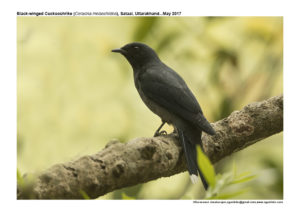Black-winged Cuckooshrike

Black-winged Cuckooshrike Coracina melaschistos
Etymology :
- Coracina : Latin word for “Raven- black”
- Melaschistos : Greek word melas –black; Latin word schistus – slate
Vernacular Names:Ben: Kabasi, Mar: KalyaPankhachaKokil-Khatik
Distribution in India: Resident in foothills of Himalayas and North East. Winter visitor is Central and East India.
Description: Size of 23-24 cm. Male is overall dark iron-grey with slaty gloss, slightly paler slate on rump and upper tail-coverts, black around eye, on cheek and on ear-coverts; wings black, glossed green, lesser upper wing-coverts dark iron-grey; retrices black, tipped white, central pair tipped grey; underparts paler towards abdomen and under tail-coverts; iris red-brown to dark brown; bill and legs black. Female is very similar to male, but paler in general, often weakly barred dark and pale grey on underparts, including vent; often has broken white eye ring and fine whitish streaks on cheek.
Habitat: It is found in deciduous forest, also broadleaf evergreen forest, open forest, edge, groves and bamboo jungle; in non-breeding season also in gardens, abandoned cultivation, open areas and woodland. Breeds at 300–2450 m; at lower elevations and in plains and valleys in non-breeding season.
Food Habits: It eats insects, mainly caterpillars, beetles and bugs. They also eat some fruit. Fairly active and conspicuous; normally forages singly or in pairs; often joins mixed-species parties. It gleans insects from leaves, usually in canopy but sometimes in undergrowth.
Breeding Habits: They breed in Mar- Aug. Their nest is a very small cup of twigs, rootlets, fibers, bark and lichens, bound with cobwebs, placed above ground on fork of tree branch. They lay a clutch of 2–4 eggs.